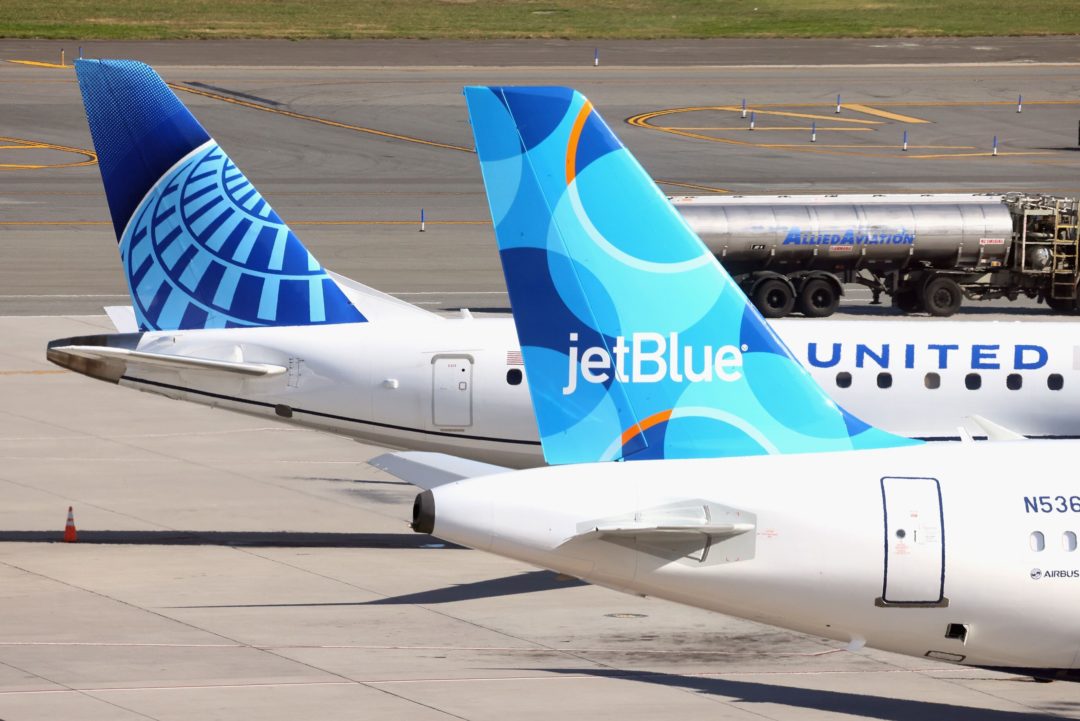
Visit Our Sponsors |
|
|
|
|
|
|
|
|
|
|
|
|
|
|
|
|
|
|
|
|
|
|
|
|
|
|
|
|
|
|
|
|
|
|
|
|
|
|

Photo: Bloomberg
JetBlue Airways Corp. is raising questions about U.S. air traffic control actions, joining United Airlines Holdings Inc. in blaming federal regulators for worsening congestion on a heavy travel week ahead of the Independence Day holiday.
Government officials dismissed the carriers’ complaints as baseless, saying weather has led to elevated flight cancellations and delays that left thousands of customers stranded in airports. JetBlue and United also claim the Federal Aviation Administration (FAA) is partly responsible for hiccups around some of the busiest airports, including New York and Denver.
The finger-pointing comes as the airline industry braces for a busy flight schedule this weekend that promises to test their resilience after severe disruptions in the summer of 2022. Carriers have increased “buffers” in their operations by adding reserve crews, but face more airspace congestion and a shortage of air traffic controllers in some cities.
“We are working with the FAA to better understand what led to the significant and unexpected ATC restrictions this week that affected thousands of flights across carriers,” JetBlue president Joanna Geraghty told employees in a message June 28. “The severity and lengthy duration of the latest programs were worse than we have seen in the past with similar weather.”
That came on the heels of complaints lodged by United chief executive officer Scott Kirby in a staff memo earlier this week that blamed operational woes on an alleged shortfall of air traffic controllers. The CEO told employees “the FAA frankly failed us” by forcing it to trim flights at Newark Liberty International Airport earlier in June, affecting 150,000 customers and prompting delays, cancellations and diversions.
The aviation agency cast doubt on those claims. “We will always collaborate with anyone seriously willing to join us to solve a problem,” the FAA said June 29 in a statement.
The agency said a shortfall of controllers in the area only contributed to cancellations and delays on June 25.
The FAA has made no changes in its procedures for directing aircraft around bad weather and is unaware of any unusual restrictions on flights in recent days, said a person familiar with the agency’s actions who asked not to be named discussing the sensitive subject.
United canceled 2,570 flights from June 24 through June 28, or 19% of its total, according to data compiled by FlightAware.com. Another 5,242, or 47%, were delayed. Of 613 flight cancellations by the afternoon of June 29, 412 were United, and 27% of its flights were delayed. About 25% of Southwest Airlines Co. flights were delayed and 24% of JetBlue flights. JetBlue canceled nearly 11% of its flights June 24 through June 28, and another 58% were delayed, according to FlightAware.
The high level of delays caused by severe storms over consecutive days contributed to thousands of customers being stranded at United hubs in Newark, New Jersey, and at Denver International Airport. Flight attendants whose schedules were disrupted spent hours on hold trying to get new assignments, according to the Association of Flight Attendants-CWA.
Transportation Secretary Pete Buttigieg also hit back at the airlines, particularly United, in recent days, saying the carrier has suffered out-sized impacts while others have recovered.
In a tweet June 29, Buttigieg posted statistics showing United’s cancellation rate since Saturday has far exceeded its competitors.
“I want to be very clear; air traffic control issues are not the No. 1 issue causing cancellations and delays,” he said in a CNN interview June 28. “They’re not even the No. 2 issue.”
This isn’t the first time Buttigieg and United’s CEO have traded blame for flight schedule chaos.
The recriminations bode ill ahead of the extended Fourth of July holiday weekend. Some 52,564 flights scheduled for June 29 make it the busiest day of the June 28-July 5 period, according to the FAA. More than 24 million passengers are expected to fly from U.S. airports, according to booking app Hopper.com, with about 3.7 million traveling June 28 and again on June 29.
In the JetBlue staff memo, Geraghty said problems “outside of our control” occurred even though it had agreed to an FAA request to cut New York City-area departures 10% this summer while adding reserve staffing and improving technology to help with recovery.
JetBlue didn’t respond to a request for more information. The cuts refer to an FAA request earlier in 2023 to reduce New York-area flights because its air-traffic center in the region has only 54% of the optimal number of controllers.
RELATED CONTENT
RELATED VIDEOS
Timely, incisive articles delivered directly to your inbox.

